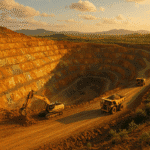Key Takeaways
- Texas data centres are projected to consume up to 399 billion gallons of water annually by 2030, constituting 6.6% of the state’s expected total usage.
- This water demand stems from energy-intensive cooling systems necessary for artificial intelligence and cloud infrastructure.
- The resulting strain presents both risks and opportunities for investors in utilities, water treatment, and green technologies.
- Innovations such as closed-loop cooling and wastewater reuse show promise but face hurdles due to high initial costs.
- Regulatory scrutiny and environmental pressures could materially impact data centre expansion and profitability in the region.
Texas faces a mounting challenge as the rapid expansion of data centres threatens to strain its water resources significantly by the end of the decade. Projections indicate that these facilities could consume up to 399 billion gallons of water annually by 2030, representing approximately 6.6% of the state’s total projected water usage. This surge, driven by the booming demand for artificial intelligence and cloud computing, underscores a critical intersection between technological growth and environmental sustainability, with profound implications for investors in infrastructure, utilities, and technology sectors.
The Escalating Water Demands of Data Centres
Data centres, the backbone of modern digital infrastructure, rely heavily on water for cooling systems to prevent overheating of servers. In Texas, a hub for tech giants due to its favourable tax incentives and energy availability, this consumption is accelerating amid a backdrop of prolonged droughts. Recent estimates from research bodies like the Houston Advanced Research Center (HARC) suggest that water usage by these centres could rise from around 49 billion gallons in 2025 to the aforementioned 399 billion gallons by 2030. This equates to roughly the volume needed to fill over 600,000 Olympic-sized swimming pools, highlighting the scale of the issue.
The mechanics are straightforward yet resource-intensive: most facilities employ evaporative cooling, where water absorbs heat from servers and evaporates, necessitating continuous replenishment. In drought-prone regions like Texas, this process exacerbates local water stress. For instance, facilities in San Antonio alone consumed 463 million gallons between 2023 and 2024, even as residents faced restrictions such as weekly lawn-watering limits under Stage 3 drought rules. Such disparities have sparked debates on resource allocation, particularly as the state grapples with climate change-induced scarcity affecting over 2 billion people globally in water-stressed areas.
Projections and Underlying Drivers
Analyst models, including those from HARC, forecast this dramatic increase based on the anticipated build-out of data centres to support AI advancements. Texas has attracted major players, with projects like Microsoft’s expansive campuses contributing to the trend. By 2030, data centres could account for 6.6% of Texas’s total water use, up from negligible levels a decade ago. This projection aligns with broader trends: the U.S. data centre industry consumed over 75 billion gallons nationwide in 2023, equivalent to the annual water needs of a major city like London.
The drivers are multifaceted. The AI boom, fuelled by companies developing large language models and machine learning applications, requires immense computational power, which in turn demands robust cooling. Texas’s appeal lies in its deregulated energy market and land availability, but water infrastructure has not kept pace. State projections from the Texas Water Development Board indicate overall water demand could rise significantly by 2030, with data centres emerging as a new, thirsty contender alongside agriculture and urban growth.
Implications for Infrastructure and Utilities
For investors, this water crunch presents both risks and opportunities in the utilities and infrastructure sectors. Water utilities in Texas, already under pressure from droughts, may face increased capital expenditures to expand supply or implement recycling technologies. Companies involved in water management, such as those specialising in desalination or efficient cooling systems, could see heightened demand. Analyst sentiment from firms like Goldman Sachs, as of mid-2025, labels this as a “high-conviction theme” in sustainable infrastructure, with potential for double-digit growth in related equities over the next five years.
Conversely, the strain could lead to regulatory hurdles. Texas lawmakers are increasingly scrutinising data centre expansions, with concerns over grid stability and water resources prompting calls for stricter permitting. If regulations tighten, development costs could rise by 15–20%, according to industry estimates, impacting profit margins for operators. This regulatory risk is particularly acute in water-scarce regions, where local opposition has delayed projects.
Technological Innovations as Mitigants
Innovation offers a pathway to temper these demands. Some data centres are shifting to closed-loop cooling systems that recycle water, reducing freshwater intake by up to 90%. Others are exploring air-cooling alternatives or locating facilities in cooler climates to minimise evaporation. Investor interest in green tech is evident: venture funding for water-efficient data solutions reached $2.5 billion globally in 2024, per PitchBook data. In Texas, pilot projects using treated wastewater for cooling could set precedents, potentially alleviating 20–30% of projected usage by 2030 if scaled effectively.
However, adoption lags due to upfront costs. Analyst models from McKinsey suggest that without widespread implementation, water consumption could exceed projections by 10% if AI demand accelerates beyond current estimates. This uncertainty underscores the need for diversified portfolios that hedge against resource constraints.
Economic and Market Ramifications
The broader economic impact on Texas is substantial. The state, already a leader in energy production, risks infrastructure overload. Data centres are projected to add billions to the economy through jobs and taxes, but at the cost of straining resources. A white paper from the Meadows Center for Water and the Environment warns that unchecked growth could lead to “horrific” local impacts, including higher water rates for consumers and potential blackouts if power and water systems falter.
From an investment perspective, this theme illuminates opportunities in resilient assets. Utilities with strong water portfolios, such as those in the S&P 500 Utilities Select Sector, have shown resilience, with average returns of 8% annually over the past three years amid volatility. Sentiment from Morningstar analysts, as of August 2025, remains cautiously optimistic, rating water infrastructure funds as “overweight” due to long-term scarcity trends.
- Risk to Tech Giants: Major operators like Microsoft could face operational disruptions or higher costs, potentially shaving 2–3% off earnings in water-stressed scenarios.
- Opportunity in Alternatives: Investments in renewable energy-integrated data centres, which often incorporate efficient cooling, are gaining traction.
- Global Context: Texas’s situation mirrors challenges in Ireland and other hubs, where power and water shortages have capped expansions.
Forecasting the Path Ahead
Looking to 2030, analyst-led forecasts from organisations like the International Energy Agency predict that global data centre water use could triple from current levels if efficiency gains stall. For Texas, a baseline model assuming moderate AI growth pegs consumption at 399 billion gallons, but sensitivity analyses suggest a range of 300–500 billion depending on regulatory and technological variables. Investors should monitor key indicators, such as state water board allocations and tech firm sustainability reports, to gauge trajectory.
In summary, the projected water demands of Texas data centres by 2030 highlight a pivotal tension between innovation and resource limits. While the sector drives economic value, it necessitates strategic investments in sustainable solutions to mitigate risks. For discerning investors, this theme offers a lens into the evolving landscape of tech-enabled growth, where water could become as critical as electricity in valuation models.
References
- Newsweek. (2024). Texas data centres pose major threat to water supplies. Retrieved from https://www.newsweek.com/texas-data-center-water-artificial-intelligence-2107500
- Austin Chronicle. (2025, July 25). Texas is still in drought – and AI data centres are quietly guzzling up water. Retrieved from https://www.austinchronicle.com/news/2025-07-25/texas-is-still-in-drought-and-ai-data-centers-are-quietly-guzzling-up-water/
- San Antonio Current. (2024). San Antonio data centres guzzled 463 million gallons of water as area faced drought. Retrieved from https://www.sacurrent.com/news/san-antonio-data-centers-guzzled-463-million-gallons-of-water-as-area-faced-drought-38116670
- DataCenters.com. (2024). Texas water crisis: The impact of data centre developments on a fragile resource. Retrieved from https://www.datacenters.com/news/texas-water-crisis-the-impact-of-data-center-developments-on-a-fragile-resource
- Texas Scorecard. (2024). Texas data centres’ thirst for water challenging state infrastructure. Retrieved from https://texasscorecard.com/state/texas-data-centers-thirst-for-water-challenging-state-infrastructure/
- Texas Water Development Board. (n.d.). Water planning data and projections. Retrieved from https://www.twdb.texas.gov/waterplanning/data/projections/index.asp
- Techie + Gamers. (2024). Texas data centres quietly draining water. Retrieved from https://techiegamers.com/texas-data-centers-quietly-draining-water/
- MacroEdge. (2024). [Post on X]. Retrieved from https://x.com/MacroEdgeRes/status/1951146443365814498
- Disclose.tv. (2024). [Post on X]. Retrieved from https://x.com/disclosetv/status/1951076934689202285
- More Perfect Union. (2024). [Post on X]. Retrieved from https://x.com/MorePerfectUS/status/1951314751385981375
- Statistic Urban. (2024). [Post on X]. Retrieved from https://x.com/StatisticUrban/status/1951284890990944732
- Mario Nawfal. (2024). [Post on X]. Retrieved from https://x.com/MarioNawfal/status/1921261705398476896
- SOIC Finance. (2024). [Post on X]. Retrieved from https://x.com/soicfinance/status/1861476903192006681














